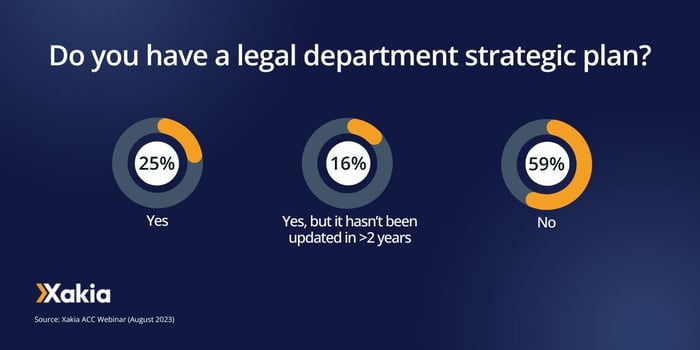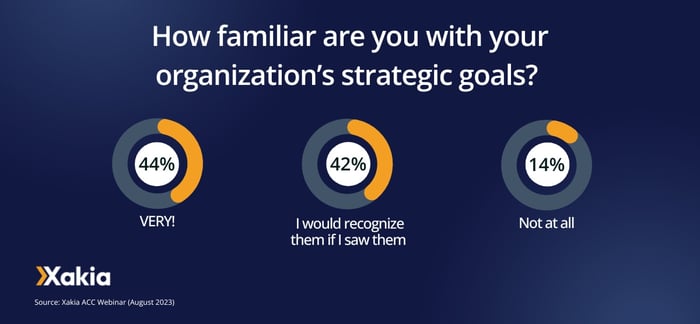A BarkerGilmore survey informs us that more than 70% of CEOs define their ideal General Counsel as a “strategic business partner and valued member of the leadership team,” yet according to a Xakia flash poll, 59% of General Counsels said they do not have a Legal Department strategic plan.

Why is a Legal Department strategic plan so important?
The Association of Corporate Counsel’s Legal Operations Maturity Model Toolkit lists five primary reasons:
➡️ Align the Legal Department with business direction and goals.
🏃Ensure the entire Legal Department is moving in the same direction.
💰 Prioritize and justify investments in resources and technology.
📊 Demonstrate the Legal Department’s value contribution and business impact to the company.
📈 Measure the success of the Legal Department planning process.
The importance of having a strategic plan is likely well understood, but how to action one often stymies GCs who are crunched for time managing day-to-day business. So how do you get there?
It can be easier than you think. Xakia developed a framework, 8 Steps to an In-House Legal Strategic Plan, that will help you build an actionable plan for your team.
How do these steps work in the field?
We sat down with Shiv Patel, Manager Legal Projects and Operations at Coverys, and Brian Matthew Rhodes, Chief Legal Officer and Corporate Secretary at Opportunity@Work, to gain insights into how legal teams of varying size and maturity tackle the strategic planning process.
Step One: Gather Intel
Guidelines:
- Look at last year and identify where your team struggled – workload, budget, personnel? – and which problems you would like to solve
- Talk to your clients and learn their goals, major projects and concerns for the upcoming year
- Talk to the boss and make sure your department objectives are aligned with the company’s strategic goals
- Talk to your team — engage the lawyers and staff to gain an understanding of the business issues that are piling up, what technology is or isn’t working, and identify recommended changes
Put Into Practice:
Ms. Patel highlighted an organized process used by the mid-size Coverys legal team. “We have ideation sessions with our team members and departments and organically come up with ideas and share thoughts. We take information gathered in these ideation sessions and find commonalities to define department goals for the year. It can be as simple as putting a Word doc up on a screen in a conference room and doing a data dump.”
Working from the hectic start-up environment facing rapid policy and regulatory changes, Mr. Rhodes added that his responsibilities include “constantly gleaning information from both internal and external sources” to inform his strategic planning.
💡 Tip: A matter management system will give you data about your work from the previous 12 months - what you did, who you did it for, your average turnaround time, on-time delivery etc. If you are having trouble getting started with this step, use data from matter management to form the basis of your discussion.
Step Two: Think Long Term
Guidelines
- Do not skip this step
- Understand your company’s strategic goals, vision and 'big hairy audacious goal' and identify them front and center on your Legal Department strategic plan
Put Into Practice:
This is a critical element underlying the Coverys ideation sessions. All “data dumps” are driven by a clear understanding of the company’s strategic goals and how Legal can help achieve them.
If you don’t know your company goals, make sure to find out. If your company doesn’t have an established strategic plan, consider being proactive on behalf of the Legal Department to set goals and tactics in line with your industry.
💡 Tip: Your website is a great place to start looking for a strategic plan, particularly if you are a listed company. If no luck there, ask the executive with responsibility for the Legal Department.

Step Three: Think Short Term
Guidelines:
- Identify the short-term projects your Legal Department should address
- Consider your organization’s position relative to its industry, regulatory landscape, geography, and workforce, and other economic considerations
Put Into Practice:
Both Ms. Patel and Mr. Rhodes operate in highly regulated industries. Mr. Rhodes revealed that his organization relies on an “integrated master plan” and works closely with state and federal public sectors to ensure they are on top of laws and regulations that will impact the organization’s mission.
Ms. Patel’s team keeps a watchful eye on state and federal regulatory changes to ensure that the legal team is always in a position to render proactive strategic guidance.
💡 Tip: Use legal matter management software to inspect your current workload, projects, capacity and sense-check this against the list that you have generated in this step. Although your brain has great capacity, you want to be sure that you are not forgetting significant short term work requirements from across your organization as you build out your strategy.
Step Four: Determine Your Major Missions
Guidelines:
- Select a few, no more than three, major missions to provide a foundation for your strategic plan and spark ideas for tactics and execution
- Highlight areas where you want to build strength or address weakness in years to come
Put Into Practice:
Both Ms. Patel and Mr. Rhodes offered creative options to develop legal department missions. As Ms. Patel explained, the Coverys team deploys an exercise where “each team member comes up with a newspaper headliner in ten words or less as to who we are as a team. From there we try to figure out our vision and mission for the year. This fun activity has been great in helping us figure out what we want to do and who we are.”
Mr. Rhodes communicated that his goal is to create internal efficiencies with the Legal Department. “I go by a five-finger approach - be knowledgeable, resourceful, legally sound, thorough, and punctual.”
💡 Tip: Remember that data is your Legal Department friend. Matter management software will allow you to measure how well you are already succeeding on some of these measures, and whether they need to be a focus for you going forward.
Step Five: Draft Your Strategic Objectives
Guidelines:
- Review your major missions
- Identify your building blocks to get you there
Put Into Practice:
For Mr. Rhodes, his building blocks involve “creating themes and metrics under each one. I articulate exactly what the legal team is going to do to hold myself accountable and for the company to hold Legal accountable.”
The Coverys team tweaks the verbiage from “strategic objectives” to “key focus areas” which has helped alleviate creative blockages. Ms. Patel explained, “we break up the discussion into categories and within those talk about people, projects, tasks and initiatives to build the objectives within the plan.”
💡 Tip: Start with no more than three strategic objectives in total for a greater likelihood of success.
Step Six: Define Success
Guidelines:
- Brainstorm: For each strategic objective, what is the ideal result?
- Think of quantifiable measures: spend, response time, cycle time, number of matters completed.
- Use emotive language and to be clear about what success feels and looks like
Put Into Practice:
Mr. Rhodes “ties the five-finger approach with metrics under each to the company’s master plan.” For instance, “under knowledgeable, we work closely with Finance and IT in the creation of relevant policies. Under resourceful, we said we would create a Legal Confluence page, a Xakia legal intake form, and a Slack page.”
For both teams, it comes down to data. Ms. Patel emphasized “we pull data from our Xakia legal analytics software and use that data to set our goals and objectives and define success. Having the data available to us has been a game changer.”
💡 Tip: The key is to find something measurable whether that's a set of tasks under each objective or specific metrics the team seeks to achieve. Legal matter management software will automate the process of gathering and measuring your success against these metrics.
Step Seven: Commit to Tactics
Guidelines:
- For each strategic objective, write the tactics you will complete to get there
- Tactics should be achievable, action-oriented, and accountable
- It’s OK to start with a few exploratory steps and build-out as you start tackling a problem
Put Into Practice:
This should be approached as straightforward as possible. Keep it clear and concise. As Ms. Patel advised “for each strategic objective or goal, we have 3-4 bulleted lists on how we’re going to accomplish that goal and what is actually being accomplished from that goal.” Don't overthink this step - just get started.
💡 Tip: Don't let your eyes be bigger than your stomach on this step. It's too easy to 'dream big' and then find that the list is overwhelming. Instead, think about each step as a small, very achievable and iterative way of achieving your bigger goals.
Step Eight: Share Your Strategic Plan
Guidelines:
- Don’t reinvent the wheel. We created a Legal Department Strategic Plan Template to fit on one page so it can be easily shared
- Sharing the Legal Department strategic plan provides focus and will drive the team to row in the same direction toward achieving key goals and objectives
Put Into Practice:
Ms. Patel's team benefits from a mature Coverys structure that operates as a well-oiled machine with a “strategy planning committee that receives all department strategic plans and provides feedback to finalize the department goals. All final department plans are available in one place and it’s nice to see where legal fits in.”
For Mr. Rhodes, the important part is transparency to allow all departments visibility into how their plans fit into the organization's integrated master plan to drive accountability.
💡 Tip: Accountability is crucial to achieving your goals. One way of keeping yourself accountable is to generate reports each month from your legal matter management software and share it with stakeholders from your business, outlining your progress from your defined metrics.

Get started with your Legal Department strategic plan now
Watch the webinar on demand with Anne Post, Brian Matthew Rhodes and Shiv Patel as they guide you through the creation of a clear and focused legal strategic plan. You can also download Xakia's legal strategic plan template so you don't have to start from scratch.
